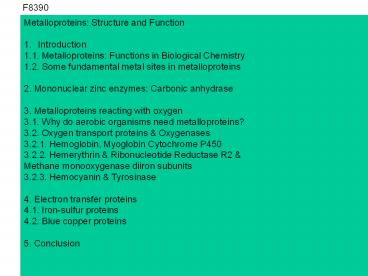Metal Ions in Biological Systems - PowerPoint PPT Presentation
Title:
Metal Ions in Biological Systems
Description:
F8390 Metalloproteins: Structure and Function Introduction 1.1. Metalloproteins: Functions in Biological Chemistry 1.2. Some fundamental metal sites in metalloproteins – PowerPoint PPT presentation
Number of Views:720
Avg rating:3.0/5.0
Title: Metal Ions in Biological Systems
1
F8390
- Metalloproteins Structure and Function
- Introduction
- 1.1. Metalloproteins Functions in Biological
Chemistry - 1.2. Some fundamental metal sites in
metalloproteins - 2. Mononuclear zinc enzymes Carbonic anhydrase
- 3. Metalloproteins reacting with oxygen
- 3.1. Why do aerobic organisms need
metalloproteins? - 3.2. Oxygen transport proteins Oxygenases
- 3.2.1. Hemoglobin, Myoglobin Cytochrome P450
- 3.2.2. Hemerythrin Ribonucleotide Reductase R2
- Methane monooxygenase diiron subunits
- 3.2.3. Hemocyanin Tyrosinase
- 4. Electron transfer proteins
- 4.1. Iron-sulfur proteins
- 4.2. Blue copper proteins
2
1. Introduction
1.1 Metalloproteins Functions in Biological
Chemistry
- Catalysis of hydrolysis and dehydration by zinc
enzymes Carbonic anhydrase - Catalysis of
electron transfer reactions Cytochromes,
non-heme-iron-enzymes, blue Cu-proteins,
iron-sulfur proteins - Transport of atom groups
(e.g., O2) Hemoglobin, Hemerythrin,
Hemocyanin) - Signal transduction Calmodulin
(Ca2-binding regulatory protein)
3
1.2. Some fundamental metal sites in
metalloproteins
Metal site Function
- Metal complexes of porphyrins and corrins
- - Iron porphyrins
- Hemoglobin Myoglobin O2 transport
- Cytochromes Redox catalysts
- - Vitamin B12 Cobalt corrinoid Radical
catalyst Methyltransferase - 2. Bridged bimetallic complexes
- - Fe2 clusters
- Hemerythrin O2 transport
- Methane Monooxygenase Hydroxylase
- Ribonucleotide Reductase RR2 Radical
generation - - Cu2 clusters
- Hemocyanin O2 transport
4
1.2. Some fundamental metal sites in
metalloproteins Continued
- Mn2 clusters O2-evolving
complex Photosystem II Mn-Catalase H2O2
disproportionation - Zn2 clusters Zinc
aminopeptidases Peptide cleavage - Ni2
clusters Urease Hydrolysis of urea 3.
Fe-S clusters Electron transfer 4.
Mo-pterin Xanthine oxidase 3. Zinc
fingers DNA binding
5
1.2. Some fundamental metal sites in
metalloproteins Exemples. Iron porphyrines
anchoring points to protein
Cytochrome c (involved in respiratory chain)
Hemoglobin/myoglobin
6
1.2. Some fundamental metal sites in
metalloproteins Co-corrin complex in cobalamin
R 5-Ado coenyzme B12
III
- Organometallic compound (M-C bond)
- 9 chiral centers
7
1.2. Some fundamental metal sites in
metalloproteins Diiron clusters
Ribonucleotide reductase R2 unit
Hemerythrin
Methane monooxygenase hydroxylase protein
8
1.2. Some fundamental metal sites in
metalloproteins Exemples. Cu2 and Mn2 clusters
Mangenese catalase (Whitaker et al., Eur. J.
Biochem. 2003, 270, 1102-1116)
Hemocyanin (oxygen transport) Cuff et
al.,J.Mol.Biol.1998
9
1.2. Some fundamental metal sites in
metalloproteins Exemples. Zn2 and Ni2 clusters
Aminopeptidase from Aeromanas proteolytica (Stampe
r et al., Biochemistry 2004, 43, 9620-9628)
Urease catalytic cycle http//www.cup.uni-muenche
n.de/ac/kluefers/ homepage/L_bac.html
10
1.2. Some fundamental metal sites in
metalloproteins Exemples. Fe-S clusters
4Fe-4S cluster http//www.steve.gb.com/science/enz
ymes.html
11
1.2. Some fundamental metal sites in
metalloproteins Exemples. Zn-fingers
Coordination of zinc in a zinc finger
Estrogen receptor mechanism
Zinc finger of the estrogen receptor is
responsible DNA-binding
Zinc finger http//www.infobiogen.fr/services/chr
omcancer/Deep/TranscripFactorsID20043.html Zinc
finger of estrogen receptor http//www.web-books.
com/MoBio/Free/Ch4F2.htm Estrogen receptor
mechanism http//www.cancer.gov/cancertopics/under
standingcancer/estrogenreceptors/
12
2. Mononuclear zinc enzymes Carbonic anhydrase
Zinc is essential to all forms of life, with an
average adult human containing ? 3 g of zinc.
The influence of Zn derives from its presence in
enzymes. An understanding of the roles that Zn
plays in biological systems requires a detailed
appreciation of how the chemistry of Zn is
modulated by its coordination environment. The
most common structural motif in Zn enzymes is one
in which a tetrahedral Zn center is attached to
the protein backbone by three amino acid
residues, with the fourth site being occupied by
the catalytically important water (or hydroxide)
ligand. Importantly, His binds to metals as a
neutral molecule, whereas Cys, Asp, and Glu bind
after deprotonation, as Cys-, Asp-, and Glu-
anions.
http//www.columbia.edu/cu/chemistry/groups/parkin
/zinc.html
13
pKa 8.9
pKa 8.26
pKa 7.0
pKa 7.0
-
-
-
Carboxypeptidase A
-
-
0
-
2-
-
-
-
-
pKa 11.2
pKa 11.2
-
-
-
P.Andersson et al, Eur. J. Biochem. 113, 425-433
(1981) W.N.Lipscomb, N. Sträter, Chem. Rev. 96,
2375-2433 (1996).
14
Carbonic anbydrase is a zinc-containing enzyme
that catalyzes the reversible hydration of carbon
dioxide CO2 H2O ? HCO3- H. In the absence
of a catalyst, this hydration reaction proceeds
with an effective first-order rate constant of
?0.01 s-1 at 37C, pH 7. This is too slow for
physiological processes. For example, CO2 must be
almost instantaneously converted into HCO3- in
muscles to be transported in the blood.
Conversely, HCO3- in the blood must be dehydrated
to form CO2 for exhalation as the blood passes
through the lungs. Carbonic anhydrases accelerate
CO2 hydration dramatically. The most active
enzymes, typified by human carbonic anhydrase II,
hydrate CO2 at rates as high as kcat 106 s-1,
or a million times a second.
15
Carbonic anbydrase is a monomeric ?29 kD protein
consisting of ?260 amino acids. Zn2 in the
active site is coordinated by three histidine
residues and a H2O/OH- ligand. ? Download the
structure of human CA II from the protein
database, code 1CA2 Highlight the Zn ion
Highlight the coordinating His94, His96, His119
ligands, and the H2O ligand
16
Catalytic cycle of carbonic anhydrase
To a buffer molecule
His64 is used as a proton shuttle between
Zn-OH2 and buffer molecules
Nucleophilic attack of water on Zn, elimination
of HCO3-
Zn-stabilized OH- ion carries out a nucleophilic
attack on CO2 carbon
? Use VMD to highlight His64 Comment your
observation
17
Possible pathway for H transfer from Zn-OH2 to
His64
C. K. Tu, D. .N. Silverman, Biochemistry 1982,
21, 6353-6360
18
? Use data from the preceding slide Examples
for Zinc enzymes and proteins to produce a plot
of pKa values for the coordintaed water molecule
as a function of the charge of the PtL3 fragment.
Interpret the result.
Tetrahedral zinc sites from zinc proteins Plot
of pKa of Zn-OH2 as a function of the charge of
the PtL3 fragment
? In the absence of other effects, pKa is in fact
expected to be a linear function of the complex
charge.































